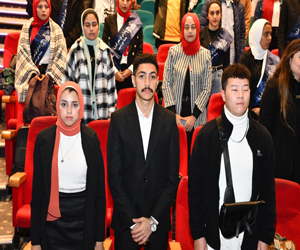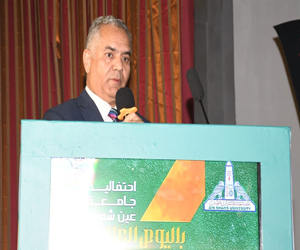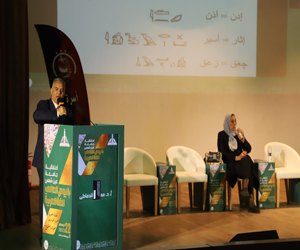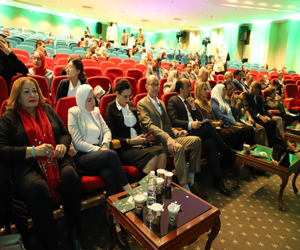Within the activities of Ain Shams University's celebration of the International Day of the Arabic Language: Prof. Dr. Mamdouh El-Damaty, former Minister of Antiquities, gave a symposium entitled "The Ancient Egyptian Language and its Impact on the Arabic Language"
Prof. Dr. Mamdouh El-Damaty, former dean of the Faculty of Archeology and former Minister of Antiquities, gave a symposium entitled "The Ancient Egyptian Language and Its Impact on the Arabic Language", as part of the celebration activities of Ain Shams University in the Arabic language, under the auspices of Prof. Dr. Mahmoud El-Meteini, President of Ain Shams University, Prof. Dr. Abdel Fattah Saoud, Vice President for Education and Student Affairs, Prof. Dr. Ayman Saleh, Vice President for Postgraduate Studies and Research, Prof. Dr. Ghada Farouk, Acting Vice President for Community Affairs and Environmental Development.
Prof Dr. Mamdouh El-Damaty explained that in order to talk about the influence of the ancient Egyptian language and its impact on the Arabic language, we must first learn about the origins of this language, as he reviewed the areas of the spread of Afro-Asian languages and their characteristics, and that they are characterized by a set of features, including the derivation of words from triple or binary roots with the addition of letters to the beginning Words or their endings, and some experts call them the group of Semitic languages.
 |
 |
|||
He explained the places of the spread of the Afro-Asian languages, namely North Africa and the Arabian Peninsula, explaining that the ancient Egyptian language is the oldest of the Afro-Asian languages and that it consists of several lines such as the hieroglyphic line, the hieratic and demotic line, and then the ancient Coptic language.
Prof. Dr. Mamdouh Eldamaty added that the hieroglyphic script has various features as it can be written vertically and horizontally or from right to left or vice versa, just as hieroglyphic writing means sacred writing, hieratic means priestly writing and this is because it refers to religious texts written on papyrus and that demotic writing is popular writing, which was more widespread and common in the late Ptolemaic and early Roman ages, and then in the third century AD.
 |
 |
|||
He touched on the emergence of the influence of Greek writing or letters on ancient Egyptian writing, especially in light of the presence of foreigners in Egypt who know the pronunciation of letters but do not know how to write them, which made them write in the colloquial language from the third century until the eleventh century.
He reviewed the features that passed from the ancient Egyptian language to the rest of the branches of the Afro-Asiatic languages, such as the direction of writing and the nominal phrase in the ancient Egyptian language, which is very similar to the Arabic language, citing some sentences from the ancient Egyptian language.
The ancient Egyptian language also contains the feminine “ta” and the adjective that follows the noun. Also present in the ancient Egyptian language are the related pronouns that refer to ownership.
Prof. Dr. El-Damaty also explained the nature of Sinaitic writing, which is derived from hieroglyphics in particular, but it was the first language to use an alphabet, indicating that the ancient Egyptian languages used monophonic alphabets and some of them were bi-phonic.
He cited the inscriptions of Wadi al-Hol, which is located between Luxor and Farshout, and these inscriptions indicate the beginning of the use of the alphabet
He explained that the origin of the Musnad line (the ancient writing in Yemen) is the Sinaitic writing, which was taken from the hieroglyphic writing, which passed through the stage of the Nabataean script, which appeared in the eastern Sinai region, Jordan and northern Saudi Arabia, and it was taken directly from the Sinaitic scribes.
Dr. Eldamaty reviewed the emergence of the Nabataean alphabet, which appeared between the second century BC and the fourth century AD, and which took its origins from the Egyptian hieroglyphs, then from the Sinaitic, Phoenician and Aramaic alphabets, all the way to the Nabataean alphabet.
And Prof. Dr. Al-Damaty classified the branches of the Arabic alphabet, explaining that the original is ultimately the Egyptian script.
At the end of the symposium, the former Minister of Antiquities cited some classical Arabic vocabulary from the origin of the ancient Egyptian language, which indicates the origin of writing, it also touched on some Egyptian colloquial vocabulary of the ancient Egyptian language.
He mentioned the origin of the word Copt, which means Egyptian, and that it has nothing to do with religion, which was mentioned by the poet "Homer" in the eighth century BC. He meant by it the land of the Nile, then the Latin "Egyptus" was derived from it, and Egypt, Egypt was derived from it, which is most of ancient Egyptian origin.
Prof. Dr. Mamdouh El-Damaty concluded his symposium with an explanation of the medical papyrus in the Museum of Lastogam, which describes instructions for applying the treatment to any part of the human body.
.svg)




